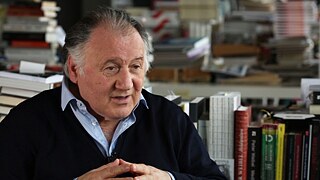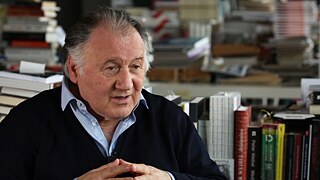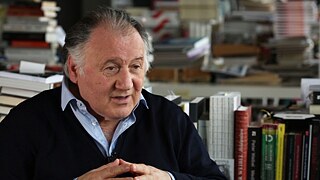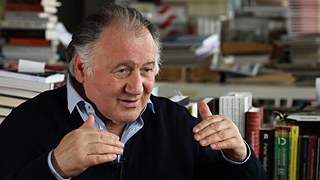Interview with Peter Weibel
Between Near and Far Sensing

Love thy stranger as thyself!
As we know, the new media are bringing about a proper upheaval of our concept of reality, even of the perception of our own bodies. To what extent does this change in reality also cause profound changes in our psyche and in public space?
Before, reality was constructed by two forms of the subject’s sense perception: on the one hand, through near sensing, that is, touching, feeling out, smelling something; and on the other hand, through the far sensing of the eye and the ear. Reality seemed to be constructed by the coordination of near and far sensing. There was a balance between near and far sensing.
For two hundred years now, electromagnetic technology has brought forth a new hierarchy: the dominance of far sensing. It was mankind’s desire to strengthen far sensing and not near sensing. That is to say, we have founded a kind of -society – by fax, radio, telephone, television, internet – and the gap between near and far sensing has thereby grown so great that near sensing no longer plays a role.
What kind of relationship arises between public and private spheres when the dichotomy between inner and outer is canceled more and more by the attributions produced by images?
Permit me a dirty example: what people call love or eroticism was the traditional scene, or battlefield, of near sensing, the contact of skin surfaces. Today, however, people enjoy its medial substitute through far sensing – that’s what a viewer or listener, whether of TV, telephone sex or YouPorn, is seeing or hearing as a viewer or listener. He is an observer of the first order. We have established a tele-society in the last two hundred years. In this regime of far sensing, the image plays the central role. The viewer says he watches television – literally, far (tele) seeing (visio). But actually he doesn’t see anything; his eyes have been dispossessed by another; they aren’t, at any rate, at the place of the happening. There, there is another. The viewer sees the world depicted in TV with the eyes of someone else. An otherwith the eyes of a camera. We’re thus living in a scopic regime.
When the identity of the individual is constituted more and more by means of images, “mediated” by images, how does this change the value system that directs the individual’s behavior in public space?
We still have no morality of far sensing. The Bible says: Thou shalt not covet thy neighbor’s wife or possessions. In reality, this should have been revised a long time ago to read: Love thy stranger – not thy neighbor – as thyself.
The Ten Commandments are designed for near sensing – for centuries we were made for nearing sensing. Now we can see over the hill and the clouds. We live in a reality constructed by far sensing and believe we can control this world with the rules of near sensing.
What relationship could be established in this context between image production, ethics and law?
Our judicial systems are also built up from the realm of near sensing. When works of art are photographed, the name of the photographer is withheld. If I’m so capable as to raze two skyscrapers to the ground, I would have the right theoretically to be named as the author, but here the photographer is cited. These are contrary positions. We haven’t yet learned to distinguish between owner and author. The dancers should also be mentioned in ethnographic photography. Civil law hasn’t understood this. In our image-addicted society, the owner dominates and the author is suppressed. This is the first problem. When I’m about to take a photo of a situation in which someone is threatened with a weapon, I have the choice of intervening or taking a picture. Here the addiction to images leads to an ethical conflict that I can’t solve humanly.
The image spares man from having to take action. The Bible already says, “Ye shall know them by their fruits”. Faith in images is the last sacral act, the last remnant of religion – as before the Reformation.
Most pictures are staged anyway. Does the image count as legal evidence? No, the court doesn’t accept the documentary character of photography.
You have always maintained that there is a strong relationship between art and science and interpreted art as a form of knowledge – that is, attributed an epistemological value to it. In what way do the new technologies change this form of knowledge?
It’s grotesque, for example, that the German photographer Andreas Gursky, who after all produces his pictures on the computer, is seen to be in the tradition of the Düsseldorf “documentary school”. The epistemological presuppositions of the image still haven’t been thought through.
Art has tragically taken leave of the realm of near sensing. Leonardo da Vinci already began dissecting and in his Trattato della pittura established the scientific character of painting. The painter disposes over the means of representation: point, line, plane and so depicts the visible form of things. Leonardo looked under the surface of things. Now we have soft scalpels, microscopes, ultrasound, and so on. This means that science has redefined the term “visible”. We take an instrument in the hand to see further than the natural eye allows. Science has satisfied Leonardo’s demand. Painters stopped at the eye. Science has shifted the zone of visible – for instance, through computer tomography; it has made the invisible visible.
Art has abdicated its position as a system explaining the world. Thank goodness there are counter-movements today. Artists now have instruments similar to those of doctors; in this way, art and science are coming closer to one another again. It means we are on the verge of a second Renaissance, which, in a very traditional way, is being combatted by painters and by the market.It also used to be said that photography isn’t art.
Imagine: in 1936-38 Man Ray published an edition of his photography with the title La Photographie n'est Pas l'Art, because he was fed with it. In the sixties everyone said that art done with media isn’t art. We then spoke of works rather than art works.
When I founded the Institute for New Media at the Städelschule in Frankfurt am Main, I was told by painters: “You’re the one who’s bringing the mechanical spirit into art”. I could only retort: “If you’re so opposed to the mechanical spirit, then you should also remove the piano from the Städel”.
One of the recurring motifs of your work revolves around the criticism of the growing importance of the free market in the interpretation of art and its public relevance. What role does the economy play in the aesthetic judgment of a work, and to what extent can this harm the disinterested contemplation of art?
You must begin with the realization that the history of great painting was the history of commission painting. Hence Svetlana Alpers’s beautiful book, Rembrandt’s Enterprise. The Studio and the Market. Today commission painting has something pejorative about it. When did the idea of autonomous art arise? Painters were contractors and they documented the history of the church and nobles, ecclesiastical, military and aristocratic power. Even renowned painters like Jan Vermeer and Diego Velázquez joined guilds as “artisans”.
It was only when the client disappeared in the nineteenth century that the free market in art arose and artists called themselves autonomous. Van Gogh worked without a commission; only then did people talk of inner necessity.
Excluded from the lucrative and traditional Salon de Paris, artists came together for the first time as the “Salon Independant” in 1884.
In this new marketplace under tents, the rule was the more scandal, the more visitors. It’s in this light that we have to understand the accusation that Manet, in his Le Déjeuner sur l'herbe, submitted to the taste of crowd. And as a matter of fact, the Salon drew 5,000 visitors because the bourgeoisie sought there what they couldn’t see at home. Even Cezanne imitated Ingres and painted odalisques. This display of vulgarity and obscenity speculated on the taste of the masses and the public. There was no talk of independence.
Then you had to increase the dosage and the artist, who presented himself as the anti-bourgeois, sought to shock the bourgeoisie: épater les bourgeois was the poetic motto, an awkward submission of the artist.
This also means that the market brought forth a radicalization. Artists showed absolute color or a picture in only red, blue and yellow (Rodtschenko, Pure Red Colour, Pure Yellow Colour, Pure Blue Colour, 1921) – a programme of reduction. Do we want another century of monochromy? Reality today has become so urgent that we must take note of it.
Together with Bruno Latour you were curator of the ground-braking exhibition Iconoclash: Beyond the Image Wars in Science, Religion and Art, and editor of the accompanying catalog. Do you share his thesis about the failure of modernity?
Modernity is a programme of reduction. The famous Bauhaus book of 1926 by Kandinsky is entitled Point and Line to Plane. Modern art isn’t abstract art; it is the self-representation of the means of representation. The object has been banished, and at the same time, with Duchamp and his anti-art, the object, the manufactured product and photography have been brought into art.
All modern art stands under the paradigm of photography and confounds to this day ownership and authorship. This is a constant copyright infringement.
That artists like Warhol, who never produced a single picture but only processed screenprints, are called painters shows the power of the incompetent market: it uses images of the yellow press, stars, accidents and has success with them. Koons avails himself of the same thing.
So art becomes more vulgar and you ask yourself today – Is it art or can I throw it away? Before, we sought the sublime; today we want to declare the ordinary sublime.
As to ISIS’s iconoclasm and the destruction of images, how are the image awareness and the cruelty of iconography to be explained?
In Western culture, the media have fulfilled their mission of making people enjoy cruelty and as many corpses as possible. The staging of cruel images makes ISIS a success. ISIS does it better; it’s learned from Hollywood as from television; it’s a competitor in the business of images, with the additional aspiration that the images be real. ISIS breeds fear and terror with images disseminated on social media.
The war of images is the continuation of war by other means. ISIS has understood this. You must realize that the European media function practically as the Image Ministry of ISIS. When Spiegel puts the Syrian terrorist who wanted to attack an airport on its cover, he’s achieved everything he set out to do. The worse the deed, the sooner you’re put on the cover of Spiegel.
We’ve permitted ourselves the indulgence of a culture in which people have grown accustomed to loathing and disgust. ISIS isn’t the Other; it’s us – it’s our mirror. The transfiguration of the ordinary has become the transfiguration of the horrible.
The media know the public has been vulgarized. This can change only if the citizens themselves, the subjects, say “We don’t want that”. But today, when, in spite of the fact that I have no television, I must pay compulsory TV fees legitimated by the state, I have no possibility of protesting against television. We’ve all been compulsorily vulgarized. This is the mass media’s ethics of ugliness.
Are the universalist ideals of modernity, still so fundamentally defended by, for example, Habermas, really no longer valid? Does a new regionalization and tribalization of values lie ahead of us?
The problem of universalism is to have neglected the question of membership. We dream as it were, of cosmopolitanism; everyone should be a citizen of the earth.
But alone through language, sex or gender and ethical affiliation, our life is built on membership and belonging. And if I’m included, then I’m also excluded. We dream of a club in which all humanity are members, but not all members of the same club. Languages, religions, ethnic groups and so on form their own clubs. If you don’t speak English, you can’t be a member of the English-speaking club. This is the dream of universalism. We can say only that we are all human beings. But when you’re standing at the border, it’s “Are you a German or a foreigner?”
You can’t be a member of three churches. We propagate the diversity of nature, of cultures, of religions as a (life-) value. If you can speak three languages, you’re not better than someone who can speak only one. Equality must be attained, but not the abolition of membership. The dream of cosmopolitanism is to abolish membership in the spirit of “cosmopolitanism and eternal peace” (Kant).
The world, however, consists of differences – thank God! If I’m a fat and not a thin person, then I have to say – and this is already difficult enough – that fat people are just as good as thin ones. We have a tendency to raze differences – with the best of intentions. In reality, however, it can’t be done; there are victims and perpetrators, murderers and murdered, and there’s a juristic tendency to equalize the two, to be more concerned in some circumstances about the murderer than about the victim.
What we can achieve is to recognize all membership as equal if it corresponds to certain value ideals that a larger group considers to be right. We’ll never achieve a condition in which everyone deems this to be right. The dream of cosmopolitan universalism rests on illusions – the annulment of membership.
MUSEUM 2.0 What is the potential of the new media for democratization today? You have addressed this question in your project YOU: The Museum and Web 2.0 and the essay “The Museum in the Age of Web 2.0”, and announced a programme in which the new technologies have the task of democratizing the institution of the museum.
Thirty years ago there were half a dozen biennials; today there are 120. Museums were a bottleneck, forever repeating the same thing: European and North American art, classical Modernism and so on. Only slowly have marginal figures now entered its purview. This form of elite culture doesn’t work anymore, and here the biennials have played a decisive role.
I’d like to have visitors who transform learning and the museum into a laboratory, where you relax in a lounge and eat and drink. The museum must become a thought and knowledge space where competent people can teach. For example, you should be able to learn how to programme there. The new technologies give us the opportunity of changing the behavior of the public in museums – not merely to look at touristic images like trophies. Today there are interactive artworks and VR technologies in which I have to move and respond myself. Museums should become learning labs where visitors are paid for their visit and for their continuing education.
Biography
Peter Weibel has written on contemporary art, the history of media, media theory, film, video art and philosophy in numerous lectures and articles. As a theorist and curator, he has championed an art and art historiography that takes into account the history of technology and science. In his capacity as a university teacher and long-time head of institutions such as the Ars Electronica, Linz, the Institute for New Media in Frankfurt am Main, and the Centre for Arts and Media (ZKM) Karlsruhe, he has influenced particularly the European computer art scene through conferences, exhibitions and publications. (Source: Wikipedia; Creative Commons Attribution-ShareAlike 3.0 Unported)




